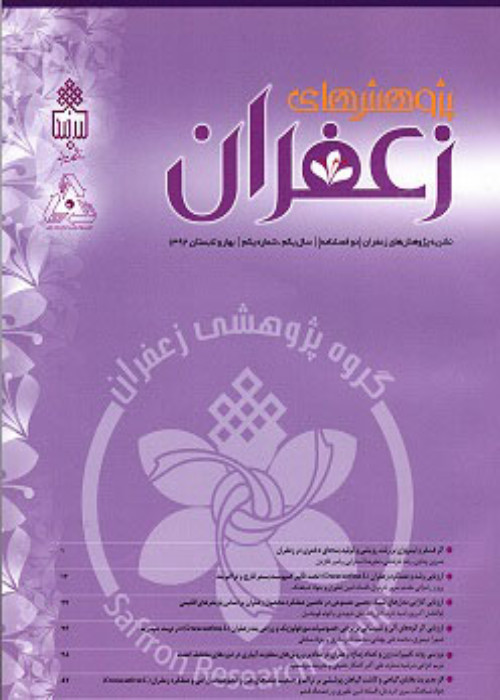Feasibility Study of Saffron Cultivation and Extraction of Its Effective Materials in Different Parts of Lorestan Province
Author(s):
Article Type:
Research/Original Article (بدون رتبه معتبر)
Abstract:
Introduction
Saffron (Crocus sativus L.) as the most expensive spice in the world, has a special situation among Iran's export products. In addition to Iran, this plant is cultivated in Spain, India, Italy and Greece. The purpose of saffron cultivation is to harvest its stigma and long style, which is transparent red in color and has a lot of medicinal and nutritional value. The performance of saffron is related to several factors such as soil, density, planting method, corm size, geographical location, atmospheric factors such as temperature fluctuations, especially during flowering time, rainfall, crop management and exploitation period. Therefore, in order to make saffron cultivation feasible, it is necessary to identify the susceptible areas in terms of climatic factors in the country in order to increase the production of saffron in the country. One of the ways to increase the yield of saffron is to increase its cultivated area by identifying areas prone to cultivation and production of this valuable medicinal plant for domestic use, export, and also to extract the important compounds in its essential oil. Therefore, this study was conducted in order to investigate the different areas prone to saffron cultivation in Lorestan province and the effect of the weather conditions of each city on the important compounds in saffron essential oil. Materials and Methods
This study was performed to investigate the compatibility of saffron and also changes in its essential oil components in different parts of Lorestan province. The experiment was conducted in the crop year 2020-21 as a randomized complete block design with three replications. In this study, 12 different cities of Lorestan province including Khorramabad, Boroujerd, Doroud, Kuhdasht, Azna, Aligudarz, Selseleh, Delfan, Aleshtar, Poldakhtar, Doreh Chegni and Romeshkan were considered as the experimental treatment. Results and Discussion
The results showed that the effect of location treatment on fresh weight of flowers, fresh weight of stigmas, dry weight of stigmas, ratio of fresh weight of stigmas to fresh weight of flowers, maximum moisture and volatiles, safranal, crocin and picrocrocin was significant at 1% probability level. The results showed that out of 12 studied cities, the amount of saffron yield was economic only in 4 cities Boroujerd, Azna, Khorramabad and Selseleh. Among these four cities, the highest flower yield (79.66 g.m-2), fresh weight of stigma (6.77 g.m-2), dry weight of stigma (1.13 g.m-2) and stigma to flower ratio ( 0.085) was obtained in saffron cultivated in Azna city. The results also showed that the highest amount of safranal essential oil was obtained in saffron cultivated in Dorud city with a maximum absorption of 54. Also, the highest amount of crocin (maximum absorption 343.5) and picrocrocin (maximum absorption 144) were obtained. After Borujerd city, the amount of picrogrosin present in saffron essential oil cultivated in Elshatr (maximum absorption 126.5) and Selesh (maximum absorption 122) cities was more than other cities of Lorestan province, and the difference between them was statistically significant. Saffron essential oil cultivated in Kohdasht city (maximum absorption 80.5) had the lowest amount of picrocrocin. There was a difference between the saffron cultivated in different cities of Lorestan province in terms of the maximum amount of moisture and volatile substances, and it was found that the saffron cultivated in Borujerd city had the highest amount of moisture and volatile compounds at the rate of 0.094%, and after this city, Dure Chegeni had the highest amount of moisture and volatile compounds of 0.082%. Conclusion
Investigating the feasibility of saffron cultivation in different parts of the country can increase its production in order to increase the country's exports. There have been different climatic areas in the country that have the ability to produce saffron, but currently they are unknown and the feasibility of cultivation should be done in them. In this study, it was found that saffron production was not possible in all the cities of Lorestan province, and the results showed that only 4 cities had the ability to produce saffron economically, and the highest production rate was in Azna city. Also, considering that the quality of saffron essential oil depends on its ingredients, based on these results, it was determined that the highest amount of safranal, crocin and picrocrocin was obtained in the saffron essential oil grown in cities with moderate climate such as Borujerd and Durud.Language:
Persian
Published:
Journal of Saffron Research, Volume:10 Issue: 2, 2022
Pages:
245 to 257
magiran.com/p2554459
دانلود و مطالعه متن این مقاله با یکی از روشهای زیر امکان پذیر است:
اشتراک شخصی
با عضویت و پرداخت آنلاین حق اشتراک یکساله به مبلغ 1,390,000ريال میتوانید 70 عنوان مطلب دانلود کنید!
اشتراک سازمانی
به کتابخانه دانشگاه یا محل کار خود پیشنهاد کنید تا اشتراک سازمانی این پایگاه را برای دسترسی نامحدود همه کاربران به متن مطالب تهیه نمایند!
توجه!
- حق عضویت دریافتی صرف حمایت از نشریات عضو و نگهداری، تکمیل و توسعه مگیران میشود.
- پرداخت حق اشتراک و دانلود مقالات اجازه بازنشر آن در سایر رسانههای چاپی و دیجیتال را به کاربر نمیدهد.
In order to view content subscription is required
Personal subscription
Subscribe magiran.com for 70 € euros via PayPal and download 70 articles during a year.
Organization subscription
Please contact us to subscribe your university or library for unlimited access!


